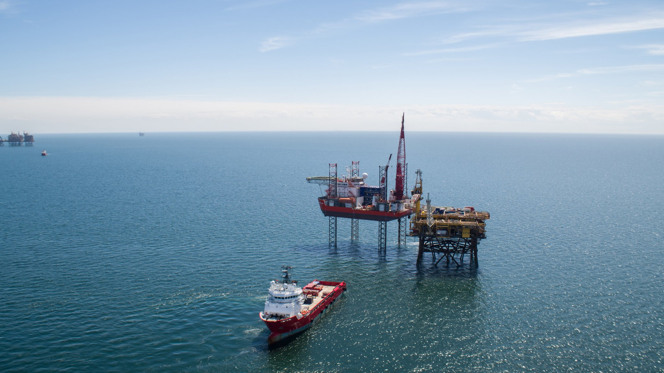Comprising the North Morecambe, South Morecambe and Rhyl fields, the Morecambe Hub at its peak met around one fifth of the UK’s domestic gas demand and is expected to remain in production until the end of this decade.
Spirit Energy plans to repurpose the depleted fields to develop Morecambe Net Zero (MNZ), the UK’s largest permanent, safe and secure carbon store, capable of storing one billion tons of CO2.The company could begin storing around four million tonnes of CO2 in the fields every year from 2030 - about 25 percent of the Government’s 2050 net zero emissions storage target. Through the company’s MNZ | Peak Cluster partnership, bringing together five of the UK’s leading cement and lime producers, the development would decarbonise 40 percent of UK cement and lime production.
The project would also provide an economic boost to the UK of approximately £1.8bn by 2050, creating and safeguarding more than 13,000 jobs across Derbyshire, Staffordshire and Cumbria, and attracting a further £5bn of investment in construction and operations work.
Spirit Energy CEO, Neil McCulloch, said:
“Reaching 40 years of production is a tremendous milestone for the company and its employees, and is testament to the dedication of all our onshore and offshore teams. The hub plays an important role in supporting UK energy security, economic growth and local employment opportunities, and can continue to do so in the decades ahead as we transform the fields for carbon storage. It is a superb example of the energy transition in action.
“Carbon storage projects such as ours can make a major contribution to the UK’s net zero goals, and MNZ is uniquely well-placed to provide scale in the right place, at the right time, and at a lower cost to support government targets and deliver its CCUS Vision with greater certainty. Our ask is modest, pragmatic policy reforms that enable MNZ and other CCS projects outside the Track process to move forward, to drive industrial decarbonisation, and to deliver new green jobs and economic growth.”
Spirit Energy and the Peak Cluster partners have called for commercially mature CCS projects which are not part of the Government’s current Track 1 and 2 process to be provided with a clear alternative route to market, to unlock private investment and ensure the UK can hit its net-zero targets. This requires reliable carbon pricing on which CCS business models can be based.
A predictable and stable carbon price trajectory that ensures emitting carbon is more expensive than storing emissions also will bolster investor confidence in UK CCS projects and minimise the necessity for taxpayer support.
Centrica Group Chief Executive and Chair of Spirit Energy, Chris O’Shea, said:
"For 40 years, Morecambe has been a cornerstone of the UK’s energy security, powering millions of homes and driving economic growth. As we look ahead, Morecambe's transformation into a world-class carbon storage hub will play an equally vital role - cutting emissions from industries like cement and lime by almost half and cementing the UK’s path to net zero. This is energy history evolving into energy future, delivering sustainability, jobs and economic opportunity for decades to come."
Today, gas from the Morecambe Hub is processed at Barrow Gas Terminal, near Barrow-in-Furness in Cumbria, before entry to the National Transmission System. Spirit Energy’s offshore facilities and onshore terminal also provide gathering and processing services for third parties.
Michelle Scrogham, MP for Barrow and Furness, said:
“Congratulations to Spirit Energy and all its employees who across four decades have produced the gas that helped keep homes warm and powered the country’s economic growth, and are now transitioning to support the energy transition. Barrow and Furness is uniquely positioned to be a true leader in clean, green energy production, through offshore wind and tidal power and Spirit Energy’s own ambitious plans to develop a world-class carbon store.
“The MNZ project can support the UK’s net zero ambitions, along with providing thousands of highly skilled green jobs in Cumbria and supporting the UK’s transition from oil and gas. These plans will bring multi-billion pounds of investment to the North West, promoting growth and attracting further regional investment that will assist us in making our local economy more sustainable.”

MORECAMBE HUB
The Morecambe Hub comprises three fields in the East Irish Sea - North Morecambe, South Morecambe and Rhyl. The fields lie approximately 25km south west of Walney Island, across blocks 110/2a, 110/3a, 110/8a and 113/27b, in water depths that range from 17 to 35m.
One of the largest gas fields in the UKCS, at its peak, the Morecambe Hub met 20% of the UK’s domestic gas demand. Despite being in production for almost 40 years, the Morecambe Hub remains a cornerstone operated asset in the Spirit Energy portfolio with the aim to produce to the end of the decade.
South Morecambe was discovered in 1974 and was the first to be developed, with production starting in 1985. The field has been developed using seven fixed jacket platforms, including the three-platform manned Central Processing Complex (CPC), four Normally Unmanned Installations (NUIs) and 36 development wells. Gas is exported via a 36” dedicated pipeline to the Barrow Gas Terminals. North Morecambe was discovered in 1976, with first gas in 1994. The development includes the normally unmanned DPPA platform which acts as the main gathering hub for the area, 10 development wells and a 12” pipeline to the Barrow Gas Terminals. Rhyl, which is north of the North Morecambe field, was discovered in 2009 and brought into production in March 2013. It has been developed as a two-well subsea tieback to DPPA.
Gas from all the fields is processed at Barrow Gas Terminals, which is located near Barrow-in-Furness in Cumbria, before entry into the National Transmission System. Spirit Energy’s offshore facilities and onshore terminal also provides gathering and processing services for third parties.
KeyFacts Energy: Spirit Energy UK country profile
 KEYFACT Energy
KEYFACT Energy